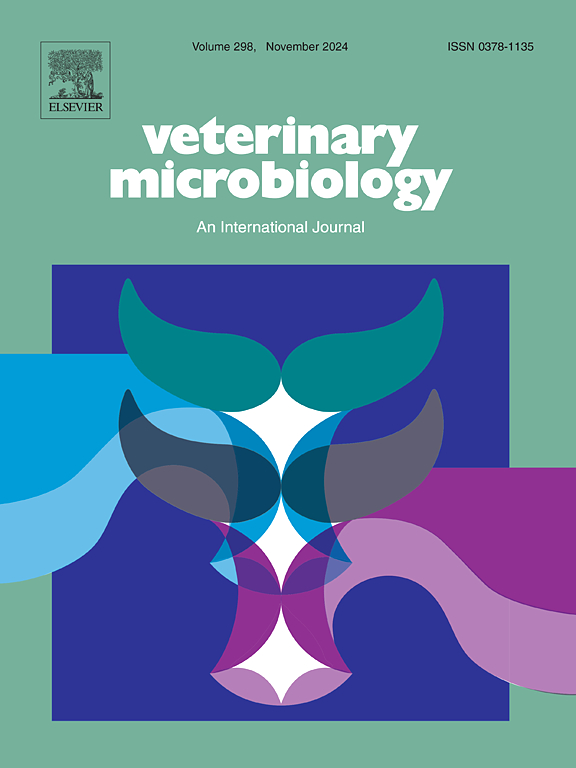Leptospira interrogans serovar Copenhageni infection and exudative glomerulonephritis in rehabilitated gray seals (Halichoerus grypus) and harbor seals (Phoca vitulina) in Ireland
IF 2.7
2区 农林科学
Q3 MICROBIOLOGY
引用次数: 0
Abstract
Leptospirosis in pinnipeds is nearly exclusively reported in California sea lions (Zalophus californianus), in which the disease is believed to be endemic. There, the Pomona serovar is the predominant cause and severe lymphoplasmacytic interstitial nephritis is the characteristic pathological finding. The present study reports on nine cases of leptospirosis in gray seals (Halichoerus grypus) and harbor seals (Phoca vitulina) diagnosed over a period of 13 months at the Seal Rescue Centre, County Wexford, Ireland. The seals presented with jaundice, additional clinical signs included labored breathing and coughing, hemoptysis, epistaxis and anorexia. The seals were either found dead or had a clinical course of 6 days maximum. During post mortem examination the main gross lesions were jaundice and varying degrees of visceral hemorrhages. Common histological findings were acute renal tubular necrosis, exudative glomerulonephritis (GN), hepatocyte dissociation and pulmonary hemorrhage. Exudative GN was characterized by markedly expanded urinary spaces filled with extravasated erythrocytes and fibrin in the absence of immune complexes. This unique lesion has only recently been associated with leptospirosis in dogs. Immunohistochemistry and/or PCR detected Leptospira sp. in the affected seals. Subsequent multilocus sequence typing using six different primer pairs targeting secY, adk, icdA, LipL41, rrs2, and LipL32 obtained sequences that closely matched L. interrogans isolates belonging to the Copenhageni serovar. The infection occurred in the center and terrestrial reservoirs such as rats are a likely source. This report details for the first time the presentation and diagnosis of an important zoonosis in seals in rehabilitation.
爱尔兰灰海豹(Halichoerus grypus)和斑海豹(Phoca vitulina)康复后血清哥本哈根感染和渗出性肾小球肾炎
鳍足类动物的钩端螺旋体病几乎只在加利福尼亚海狮(Zalophus californianus)中报道,这种疾病被认为是地方性的。在那里,Pomona血清型是主要病因,严重淋巴浆细胞间质性肾炎是特征性病理表现。本研究报告了13个月期间在爱尔兰韦克斯福德郡海豹救援中心诊断的9例灰海豹(Halichoerus grypus)和斑海豹(Phoca vitulina)的钩端螺旋体病。海豹表现为黄疸,其他临床症状包括呼吸困难和咳嗽,咯血,鼻出血和厌食。这些海豹要么被发现死亡,要么有最多6天的临床病程。尸检时主要肉眼病变为黄疸和不同程度的内脏出血。常见组织学表现为急性肾小管坏死、渗出性肾小球肾炎(GN)、肝细胞分离和肺出血。渗出性GN的特征是在没有免疫复合物的情况下,尿腔明显扩大,充满外渗的红细胞和纤维蛋白。这种独特的病变直到最近才与犬钩端螺旋体病有关。免疫组织化学和/或聚合酶链反应检测到感染海豹的钩端螺旋体。随后,使用6对不同的引物对对secY、adk、icdA、LipL41、rrs2和LipL32进行多位点序列分型,获得了与哥本哈根血清型分离的疑问L.菌株密切匹配的序列。感染发生在中心,鼠等陆地宿主是可能的传染源。本文首次详细介绍了一种重要的海豹人畜共患病的表现和诊断。
本文章由计算机程序翻译,如有差异,请以英文原文为准。
求助全文
约1分钟内获得全文
求助全文
来源期刊

Veterinary microbiology
农林科学-兽医学
CiteScore
5.90
自引率
6.10%
发文量
221
审稿时长
52 days
期刊介绍:
Veterinary Microbiology is concerned with microbial (bacterial, fungal, viral) diseases of domesticated vertebrate animals (livestock, companion animals, fur-bearing animals, game, poultry, fish) that supply food, other useful products or companionship. In addition, Microbial diseases of wild animals living in captivity, or as members of the feral fauna will also be considered if the infections are of interest because of their interrelation with humans (zoonoses) and/or domestic animals. Studies of antimicrobial resistance are also included, provided that the results represent a substantial advance in knowledge. Authors are strongly encouraged to read - prior to submission - the Editorials (''Scope or cope'' and ''Scope or cope II'') published previously in the journal. The Editors reserve the right to suggest submission to another journal for those papers which they feel would be more appropriate for consideration by that journal.
Original research papers of high quality and novelty on aspects of control, host response, molecular biology, pathogenesis, prevention, and treatment of microbial diseases of animals are published. Papers dealing primarily with immunology, epidemiology, molecular biology and antiviral or microbial agents will only be considered if they demonstrate a clear impact on a disease. Papers focusing solely on diagnostic techniques (such as another PCR protocol or ELISA) will not be published - focus should be on a microorganism and not on a particular technique. Papers only reporting microbial sequences, transcriptomics data, or proteomics data will not be considered unless the results represent a substantial advance in knowledge.
Drug trial papers will be considered if they have general application or significance. Papers on the identification of microorganisms will also be considered, but detailed taxonomic studies do not fall within the scope of the journal. Case reports will not be published, unless they have general application or contain novel aspects. Papers of geographically limited interest, which repeat what had been established elsewhere will not be considered. The readership of the journal is global.
 求助内容:
求助内容: 应助结果提醒方式:
应助结果提醒方式:


